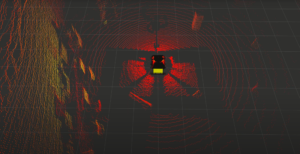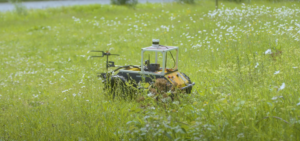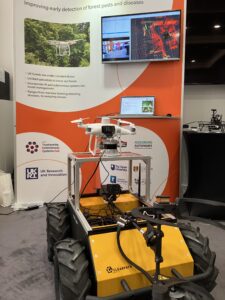Exploring the Potential of AI to Help Manage Large Forests
The health of UK trees is under threat from diseases, such as ash dieback, and insect ‘pests’. The Ips typographus, for example, is a European spruce bark beetle that has recently entered the UK. If this beetle is allowed to spread it will cause significant damage to the spruce tree population, which makes up roughly 48% of Scotland’s forests. Essentially the Ips typographus can devastate Scotland’s lumber industry.

It is vital that woodland managers can effectively detect trees that are potentially infected or infested, allowing early treatment to mitigate spread.
The challenges:
- UK woodlands are vast, covering around 3.25 million hectares.
- We have a limited supply of experts, with a 2019 report from Imperial College London finding the UK has only around 200 tree health specialists.
- Traversing the forest is intrinsically dangerous due to the dense understory, leading to the process taking a substantial amount of time to inspect a forest.
- There is also the potential dangers of tree climbing if a sample is required for lab testing.
Our work
The ASPEN project was a 12 month TAS Pump Priming project, with the aim of investigating the benefits and practicalities of utilising AI and autonomous systems for forest health maintenance.
To succeed, ASPEN had to be a multidisciplinary project drawing expertise from several disciplines such as environmental social science, law, computer science, and robotics.
We conducted a literature survey and there is a plethora of research and technology available for forest inspections. There is not, however, much consideration for how these components would actually be realised.
A good example of this is machine learning (ML), which is when a computer learns patterns within data, processing hyperspectral sensor data. Hyperspectral sensors capture hundreds of bands of light invisible to the human eye, which can give an indication if a tree has early stress, which could be caused by a pest or disease. However, it is not clear which bands are most, or at all, useful for the ML to exploit, as different bands might give different information depending upon the specific disease and/or time of year. Research has already indicated that filtering out non-informative bands would raise the ML’s accuracy, but again it is unclear to even the experts of how best to do this. This alongside general data collection concerns (see Seeking feedback), has informed that there is fundamental research still to be done. Thus improving data collection with the use of autonomous systems, and better standardisation would greatly improve our understanding. This then allows better ML models to be trained as we can inject our own knowledge into the training process. We along with our industrial partners have identified this as a key issue to be tackled in a future project.
We also codified a framework of the forest management process to:
- Resist: how can the forest be structured to be naturally resistant to P&D
- Detect: what are the best methods of identifying stressors
- Test: conducting tests on trees suspected of being infected
- Treat: removing the P&D, typically done with felling and/or burning
- Adapt: how can we improve this process as a whole given what we have learned.

From the literature we have then provided insight into how autonomous systems can be integrated into each of these steps. They will vary from case to case, and so we have focused on two problems; identifying trees naturally resistant to ash dieback, and identifying oak processionary moths. Examples include ground vehicles performing routine scans, to drones collecting physical samples. This work has allowed a significant first step into understanding the full ramifications of bringing AI and robotics out of the lab and into forest maintenance.
The literature survey also highlighted that there is a variety of resources available, from satellites, to ground vehicles, to drones. The woodland managers are also a vital component that should still be exploited. We therefore began researching how we could construct models of synthesised plans, which would consider multiple objectives such as maximising area of the forest to be covered, minimising costs/risks, and minimising the time of identifying potentially infected trees to mitigate spread. The solution needs to be flexible as the environment/resource may change (a storm has changed the forest’s landscape or a drone’s performance degrades over time), or the woodland managers perhaps might want to make a compelling case to purchase new equipment. Therefore we opted to use genetic programming to construct our models. Genetic programming is a meta-heuristic technique for constructing programs that operates by first generating a pool of solutions (or in this instance models), and using evolutionary techniques of selection, mating, and mutation genetic programming leads to a collection of solutions that are pareto optimal. A pareto optimal solution simply means that no other solution is better than this solution in all objectives (for example the solution might be the riskiest, most time consuming, but it is however the cheapest). To the best of our knowledge this is a novel usage of genetic programming.
ASPEN attracted a couple of final year students to collaborate with us as interns. This has produced a light-weight simulator for a swarm of drones tasked with surveying a forest. The simulator allows a user to compare different swarm algorithms and conduct a series of experiments for data collection with the simulator’s testbed. Additionally we have constructed a simple LLM interface for users to interact with our testbed (see Developing an in-house testbed), as a benefit of LLMs is allowing non-technical experts a way of interacting with the autonomous systems. We have also established a connection with the Conservationists Volunteers (TCV), who are interested in how we could deploy these systems for inspection. We are in early stages of discussion with the first step being visits to our labs, but aiming to pursue this relationship going forward.
The social, political, and legal implications of the deployment of autonomous systems and drones within the UK’s woodlands has also been a key area of focus for the project. While the deployment of AS could have major advantages to forestry, it also raises significant questions with regard to ethical practice and proper governance. What is considered proper and effective regulation of such technologies when deployed in public spaces is a field very much ‘in progress’, and the public’s perception and acceptance of sharing such spaces with autonomous platforms is similarly undergoing rapid evolution. As such, ASPEN has been exploring the deployment of a process that refines high-level social, legal, ethical, empathetic, and cultural (‘SLEEC’) principles into operational practice with regard to woodland management, and thus will always ensure that such technologies are deployed in a safe and human-centric manner, and one which protects the privacy and common rights of all those accessing a woodland.
Seeking feedback

We demonstrated some of our work at the TASshowcase2024 in London. The delegates that visited our booth showed great interest, and we had an interesting discussion regarding digital twins at the AI for Environment and Energy panel. A digital twin is, ideally, a perfect simulation of a physical process, and a question was raised to us about the effectiveness of employing them. The largest concern is we need to have substantial data to construct these digital twins which is simply lacking. This is due to a few reasons including that if a pest or disease is detected then it should be terminated as soon as possible, and we do not know how invasive species will behave if they enter the UK. Our industrial partners echoed a similar concern that even though there is more and more data being collected, we do not know how best to standardise or normalise this data.
Developing an in-house testbed
Another key goal of the ASPEN project was to develop an inhouse testbed so that we can begin to answer some of the technical questions raised, including how one formulates a plan using heterogeneous components (see ‘Our work’). A testbed allows researchers to conduct experiments in controlled environments. Our testbed is based at the Institute for Safe Autonomy, and consists of a mix of autonomous ground vehicles, such as the Husky robot, and aerial drones including the autonomous PX4-Vision and Phantom Pro 4. This allows us to showcase a potential end-to-end process of how systems could be deployed to significantly help the woodland managers. The drone, for example, could first explore the environment to find potentially infected trees, which then gives coordinates to the ground vehicle to drive to and retrieve a sample. The woodland manager is present in the process the whole time, being provided with consistent updates from the deployed systems. Regarding the sampling process, we have also been successful in testing the DeLeaves sampling tool from Outreach Robotics at our facilities. This includes both an indoor and outdoor flight, which is key to demonstrating our skills for taking this work forward.
You can read more about this project here.
Here is a film about this project.
Here is a film of a test flight with the drone.